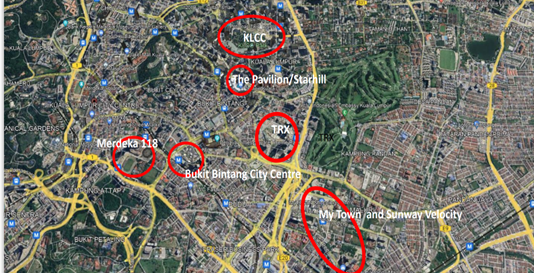The earliest application of Artificial Intelligence (AI) was a computer chess game developed by IBM called the “Deep Blue” supercomputer, beating world chess champion Garry Kasparov on 11th May 1997. In later years, AI has helped in the development of affective and emotional “Kismet Robot” (1998) by MIT’s Dr. Cynthia, “Roomba” the autonomous robotic vacuum cleaners (2002) by iRobot company, “Siri” of Apple iPhone (2008) and “Alexa” of Amazon (2014), both are a virtual assistant tool, as well as “Sophia”; a social humanoid robot developed by Hong Kong’s Hanson Robotics in 2016.
In recent years, specifically late 2022 is the booming time of AI applications in many fields especially in creative art. It was a fun, harmless and an eureka way to explore combinations of art and smart digital experience. Now, it has become a professional discourse. Here are some examples of AI applications in design:
AI in Paintings
The history of AI application in paintings started in 1973 by a Visual Art professor at the University of California, San Diego, Professor Harold Cohen. He created a computer program called AARON that can do abstract drawings. Cohen developed a “turtle” robot that allows AARON to produce physical artwork with black ink and then Cohen himself coloured the paintings. Later, AARON is enhanced with Lisp Programming Language inside a flatbed plotter machine that can do colouring capabilities.
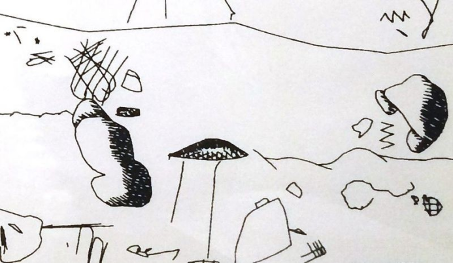
Left: Untitled AARON drawing, ca. 1980. Right: AARON “turtle” machine, doing drawings
(Both images source: computerhistory.org (2016))

Cohen (standing right) with a painting machine at the Computer Museum in Boston in 1995
(Source: nytimes.com (2016)).
In 2018, a famous and controversial digital painting created by “Obvious” from Paris, “Edmond De Belamy” from the “La Famille De Belamy” painting collections was claimed as the first AI-generated portrait painting. Obvious developer claimed that they are using a trained algorithm with inputs from 15,000 portraits, painted a man dressed in a dark coat with a white collar, with a blurry-man image, signed with a mathematical formula “min G max D Ex [log (D(x))]+Ez [log(1 – D (G(z)))]”, the algorithm used to create Obvious. The painting is currently auctioned for USD432,500 in Christie’s New York. What is controversial about Edmond De Belamy painting is that the coding for the painting was found borrowed from open-source licence algorithm Generative Adversarial Network (GAN) codes from the work of Robbie Barrat, who is also a graphic designer, based in the US.
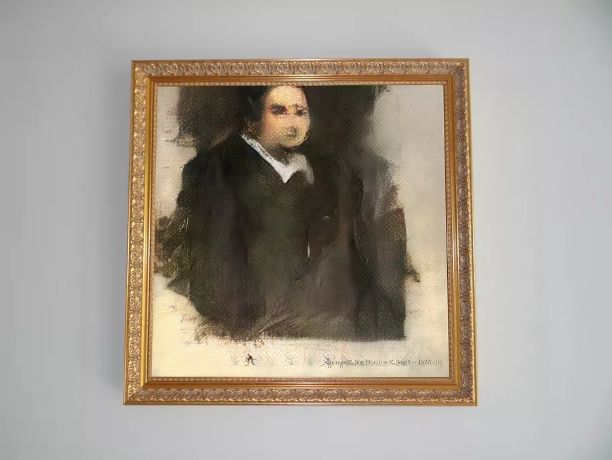
“Edmond De Belamy” (2018) at the wall of Christie’s New York auction house
(Source: nytimes.com (2018))
AI in Sculpture Design
Another significant AI artworks are a collection of sculpted stone vases named “RIPPLE” from the designer Layth Mahdi, an Iraqi-born UAE-based architect and designer. He is an avid robotic fabricator that uses AI in most of his works, in fact, created the highly advanced robot himself to sculpt solid and rigid material into the looks of very fluid, organic and lightweight. The pieces have undulating surfaces and fluid forms that were machined using 7-Axis robots. Each of the vases took about seven to eight hours to sculpt. "The robot for me acts as a digital, very flexible yet precise carver. I believe the future is collaborative," Mahdi stated.
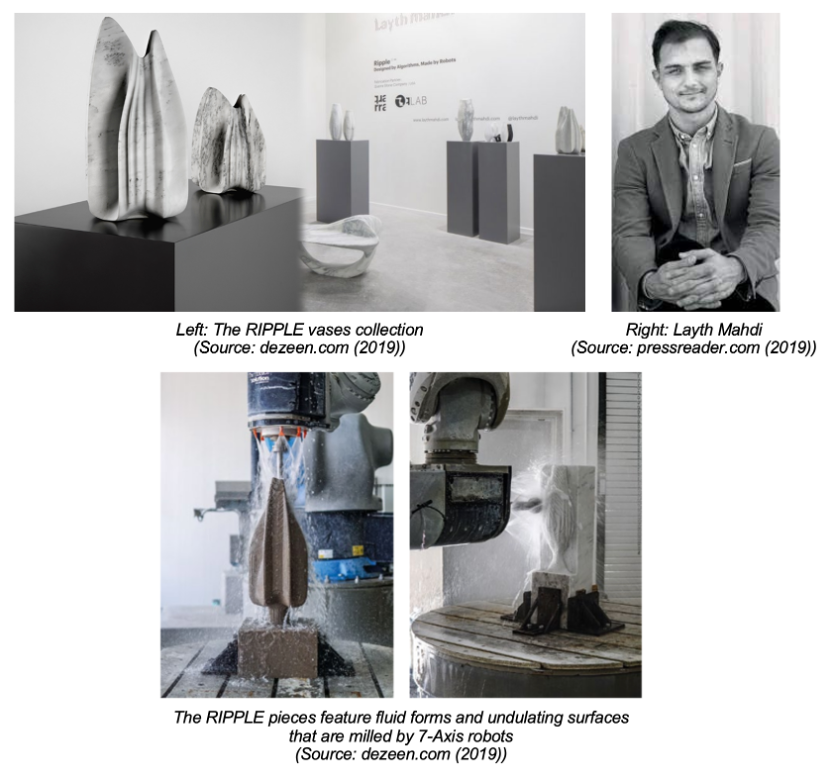
AI in Furniture Design
The first chair ever developed by AI and in production was designed by Philippe Starck and an Italian furniture company, Kartell. The chair is aptly named “A.I”. Starck compared the design process to a dialogue with an algorithm that can create a strong, stable chair using minimal material. The design process gave inputs to the Autodesk AI software to learn both Starck’s futuristic approach to design and Kartell’s aesthetic preferences. In the process of 3D CAD modelling, both Starck and Kartell join forces with Autodesk to build the plastic furniture masterpiece. The programme was instructed on the injection moulding manufacturing machine.

Philippe Starck with the first chair designed with AI named “A.I”, his project with Kartell, Italy
(Source: designboom.com (2020))
Another furniture design projects using AI are the works of Philipp Schmitt & Steffen Weiss, called “The chAIr project”. Most of their works are conceptual and not in production yet but the AI-designed furniture is very interesting and unique. They believe human and AI co-creativity can possibly extend human imaginative capacities.
A different approach than Starck and Kartell which uses 3D CAD, the “chAIr Project” uses 2D image GAN AI, then the designers tweak it a little bit and produce a mock prototype.

Egon Chair - The chAIr Project: starting from AI-generated image via sketch to prototype by Philipp Schmitt & Steffen Weiss
(Source: steffen-weiss.design.com)
in Product Design
AI incorporation in manufacturing design and engineering was established in the late 70s, but there was little significant progress until the late 1990s. Many computer engineers were trying to build an automated machine that can analyse, and manufacture products without human involvement. The significant expectations from AI results were to lower production costs, improve manufacturing accuracy, and reduce error. Generative Design is another name for AI, used in product design and manufacturing. Numerous industries, including manufacturing, architecture, aerospace, and consumer goods, use generative design. Generative designers usually make an effort to solve complex technical issues.
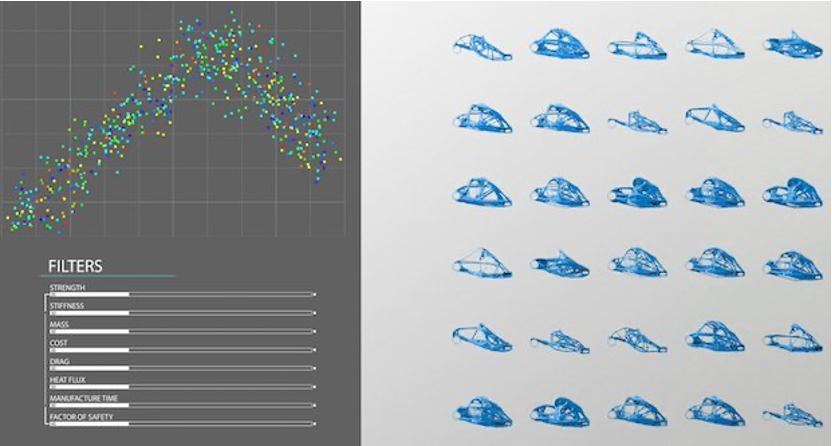
Result of AI-powered Autodesk Fusion 360 generative design of Electric Bike swing arm
(Source: blogs.autodesk.com (2018))
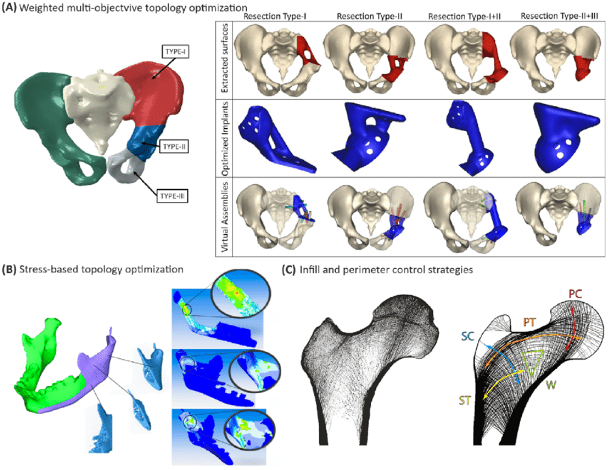
Example of generative design in bone replacement
(Source: Davoodi et. al (2021))
For instance, designers and engineers in the automotive manufacturing sector use generative design to reduce component weights, strengthen weak design elements, cut production costs by consolidating components, and shorten the time to market for new vehicles. Similar to this, designers in the sports equipment sector use generative design to maximise product performance while minimising production costs, as well as in medical cases, where designs of human bone replacement using generative design are evolving.
In conclusion, AI is a tool to assist artists and designers to experiment with intelligent systems and explore more creative inspiration. Although there are concerns about authenticity and artwork and design originality, copyright infringements and style replication, the results from AI-generated artwork are at the hands of humans to decide whether to appreciate it as an art piece or to gain profit from it.
Tarikh Input: 04/08/2023 | Kemaskini: 04/08/2023 | uswahhasanah
PERKONGSIAN MEDIA




















